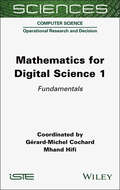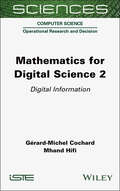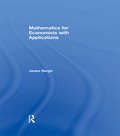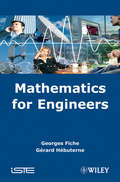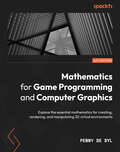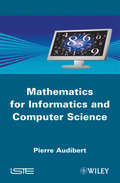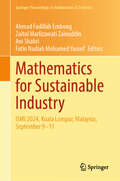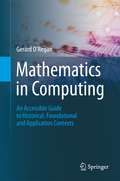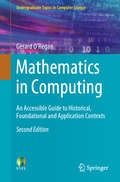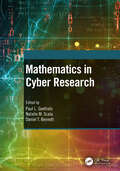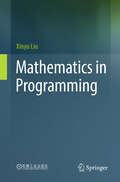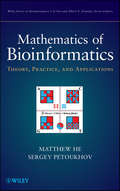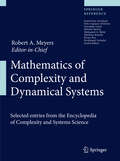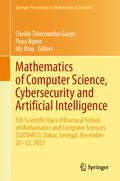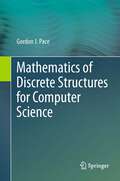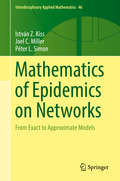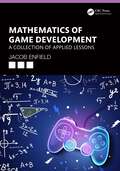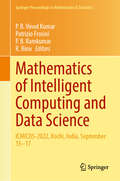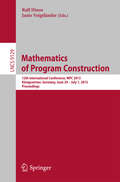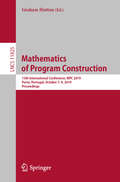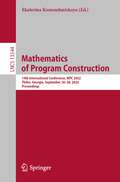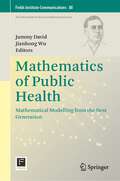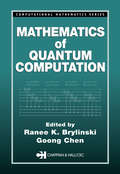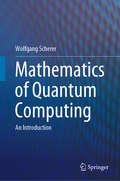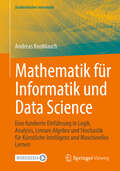- Table View
- List View
Mathematics for Digital Science, Volume 1: Fundamentals (ISTE Consignment)
by Gerard-Michel Cochard Mhand HifiOver the past century, advancements in computer science have consistently resulted from extensive mathematical work. Even today, innovations in the digital domain continue to be grounded in a strong mathematical foundation. To succeed in this profession, both today's students and tomorrow’s computer engineers need a solid mathematical background. The goal of this book series is to offer a solid foundation of the knowledge essential to working in the digital sector. Across three volumes, it explores fundamental principles, digital information, data analysis, and optimization. Whether the reader is pursuing initial training or looking to deepen their expertise, the Mathematics for Digital Science series revisits familiar concepts, helping them refresh and expand their knowledge while also introducing equally essential, newer topics.
Mathematics for Digital Science, Volume 2: Digital Information (ISTE Invoiced)
by Mhand Hifi Gérard-Michel CochardOver the past century, advancements in computer science have consistently resulted from extensive mathematical work. Even today, innovations in the digital domain continue to be grounded in a strong mathematical foundation. To succeed in this profession, both today’s students and tomorrow’s computer engineers need a solid mathematical background. The goal of this book series is to offer a solid foundation of the knowledge essential to working in the digital sector. Across three volumes, it explores fundamental principles, digital information, data analysis, and optimization. Whether the reader is pursuing initial training or looking to deepen their expertise, the Mathematics for Digital Science series revisits familiar concepts, helping them refresh and expand their knowledge while also introducing equally essential, newer topics.
Mathematics for Economists with Applications
by James BerginMathematics for Economists with Applications provides detailed coverage of the mathematical techniques essential for undergraduate and introductory graduate work in economics, business and finance. Beginning with linear algebra and matrix theory, the book develops the techniques of univariate and multivariate calculus used in economics, proceeding to discuss the theory of optimization in detail. Integration, differential and difference equations are considered in subsequent chapters. Uniquely, the book also features a discussion of statistics and probability, including a study of the key distributions and their role in hypothesis testing. Throughout the text, large numbers of new and insightful examples and an extensive use of graphs explain and motivate the material. Each chapter develops from an elementary level and builds to more advanced topics, providing logical progression for the student, and enabling instructors to prescribe material to the required level of the course. With coverage substantial in depth as well as breadth, and including a companion website at www.routledge.com/cw/bergin, containing exercises related to the worked examples from each chapter of the book, Mathematics for Economists with Applications contains everything needed to understand and apply the mathematical methods and practices fundamental to the study of economics.
Mathematics for Engineers
by Gerard Hebuterne Georges FicheThis book offers comprehensive coverage of all the mathematical tools needed by engineers in the field of processing and transport of all forms of information, data and images - as well as many other engineering disciplines. It provides essential theories, equations and results in probability theory and statistics, which constitute the basis for the presentation of signal processing,information theory, traffic and queueing theory, and reliability. The mathematical foundations of simulation are also covered. The book's accessible style will enable students, engineers and researches new to this area to advance their knowledge of communication and other engineering technologies; however, it will also serve as a useful reference guide to anyone wishing to further explore this field.
Mathematics for Game Programming and Computer Graphics: Explore the essential mathematics for creating, rendering, and manipulating 3D virtual environments
by Penny de BylA comprehensive guide to learning fundamental 3D mathematical principles used in games and computer graphics by exampleKey FeaturesGet acquainted with the essential mathematics needed to describe, simulate, and render 3D creationsConstruct and manipulate 3D animated environments using Python, Pygame, and PyOpenGLDevelop vertex and fragment shaders in OpenGL shader language to speed up renderingBook DescriptionMathematics is an essential skill when it comes to graphics and game development, particularly if you want to understand the generation of real-time computer graphics and the manipulation of objects and environments in a detailed way. Python, together with Pygame and PyOpenGL, provides you with the opportunity to explore these features under the hood, revealing how computers generate and manipulate 3D environments.Mathematics for Game Programming and Computer Graphics is an exhaustive guide to getting “back to the basics” of mathematics, using a series of problem-based, practical exercises to explore ideas around drawing graphic lines and shapes, applying vectors and vertices, constructing and rendering meshes, and working with vertex shaders. By leveraging Python, Pygame, and PyOpenGL, you'll be able to create your own mathematics-based engine and API that will be used throughout to build applications.By the end of this graphics focussed book, you'll have gained a thorough understanding of how essential mathematics is for creating, rendering, and manipulating 3D virtual environments and know the secrets behind today's top graphics and game engines.What you will learnGet up and running with Python, Pycharm, Pygame, and PyOpenGLExperiment with different graphics API drawing commandsReview basic trigonometry and how it's important in 3D environmentsApply vectors and matrices to move, orient, and scale 3D objectsRender 3D objects with textures, colors, shading, and lightingWork with vertex shaders for faster GPU-based renderingWho this book is forThis book is for programmers who want to enhance their 3D mathematics skills relating to computer graphics and computer games. Knowledge of high school–level mathematics and a working understanding in an object-orientated language is needed to grasp the contents present in this book.
Mathematics for Informatics and Computer Science
by Pierre AudibertHow many ways do exist to mix different ingredients, how many chances to win a gambling game, how many possible paths going from one place to another in a network ? To this kind of questions Mathematics applied to computer gives a stimulating and exhaustive answer. This text, presented in three parts (Combinatorics, Probability, Graphs) addresses all those who wish to acquire basic or advanced knowledge in combinatorial theories. It is actually also used as a textbook. Basic and advanced theoretical elements are presented through simple applications like the Sudoku game, search engine algorithm and other easy to grasp applications. Through the progression from simple to complex, the teacher acquires knowledge of the state of the art of combinatorial theory. The non conventional simultaneous presentation of algorithms, programs and theory permits a powerful mixture of theory and practice. All in all, the originality of this approach gives a refreshing view on combinatorial theory.
Mathematics for Sustainable Industry: ISMI 2024, Kuala Lumpur, Malaysia, September 9–11 (Springer Proceedings in Mathematics & Statistics #496)
by Ahmad Fadillah Embong Zaitul Marlizawati Zainuddin Ani Shabri Fatin Nadiah Mohamed YussofThis volume gathers selected, peer-reviewed contributions presented at the 5th International Seminar on Mathematics in Industry – ISMI2024, held on September 9-11, 2024 in Kuala Lumpur, Malaysia. Articles in this volume touch on fields such as applied mathematics, applied probability theory and stochastic modeling, statistical modeling, operations research, biomathematics, optimization, inventory management, supply chain, and computational mathematics, all with an emphasis on solutions to real-world problems. Many of the studies contained here closely relate to the United Nations&’ Sustainable Development Goals, namely SDG 9 (Industry) and SDG 3 (Health), potentially inspiring practitioners and scholars to deploy these findings and pursue similar avenues of research. Since its inception in 2013, ISMI has been organized by the Centre for Industrial and Applied Mathematics (UTM-CIAM) and the Department of Mathematical Sciences, Universiti Teknologi Malaysia (UTM) with the aims of disseminating knowledge, sharing experiences in research on various aspects of industrial mathematics and statistics and fostering collaboration among academia, government agencies, industry, and community.
Mathematics in Computing
by Gerard O’reganThis clearly written and enlightening textbook provides a concise, introductory guide to the key mathematical concepts and techniques used by computer scientists. Topics and features: ideal for self-study, offering many pedagogical features such as chapter-opening key topics, chapter introductions and summaries, review questions, and a glossary; places our current state of knowledge within the context of the contributions made by early civilizations, such as the ancient Babylonians, Egyptians and Greeks; examines the building blocks of mathematics, including sets, relations and functions; presents an introduction to logic, formal methods and software engineering; explains the fundamentals of number theory, and its application in cryptography; describes the basics of coding theory, language theory, and graph theory; discusses the concept of computability and decideability; includes concise coverage of calculus, probability and statistics, matrices, complex numbers and quaternions.
Mathematics in Computing: An Accessible Guide to Historical, Foundational and Application Contexts (Undergraduate Topics in Computer Science)
by Gerard O’ReganThis illuminating textbook provides a concise review of the core concepts in mathematics essential to computer scientists. Emphasis is placed on the practical computing applications enabled by seemingly abstract mathematical ideas, presented within their historical context. The text spans a broad selection of key topics, ranging from the use of finite field theory to correct code and the role of number theory in cryptography, to the value of graph theory when modelling networks and the importance of formal methods for safety critical systems.This fully updated new edition has been expanded with a more comprehensive treatment of algorithms, logic, automata theory, model checking, software reliability and dependability, algebra, sequences and series, and mathematical induction.Topics and features: includes numerous pedagogical features, such as chapter-opening key topics, chapter introductions and summaries, review questions, and a glossary; describes the historical contributions of such prominent figures as Leibniz, Babbage, Boole, and von Neumann; introduces the fundamental mathematical concepts of sets, relations and functions, along with the basics of number theory, algebra, algorithms, and matrices; explores arithmetic and geometric sequences and series, mathematical induction and recursion, graph theory, computability and decidability, and automata theory; reviews the core issues of coding theory, language theory, software engineering, and software reliability, as well as formal methods and model checking; covers key topics on logic, from ancient Greek contributions to modern applications in AI, and discusses the nature of mathematical proof and theorem proving; presents a short introduction to probability and statistics, complex numbers and quaternions, and calculus.This engaging and easy-to-understand book will appeal to students of computer science wishing for an overview of the mathematics used in computing, and to mathematicians curious about how their subject is applied in the field of computer science. The book will also capture the interest of the motivated general reader.
Mathematics in Cyber Research
by Paul L. GoethalsIn the last decade, both scholars and practitioners have sought novel ways to address the problem of cybersecurity. Innovative outcomes have included applications such as blockchain as well as creative methods for cyber forensics, software development, and intrusion prevention. Accompanying these technological advancements, discussion on cyber matters at national and international levels has focused primarily on the topics of law, policy, and strategy. The objective of these efforts is typically to promote security by establishing agreements among stakeholders on regulatory activities. Varying levels of investment in cyberspace, however, comes with varying levels of risk; in some ways, this can translate directly to the degree of emphasis for pushing substantial change. At the very foundation or root of cyberspace systems and processes are tenets and rules governed by principles in mathematics. Topics such as encrypting or decrypting file transmissions, modeling networks, performing data analysis, quantifying uncertainty, measuring risk, and weighing decisions or adversarial courses of action represent a very small subset of activities highlighted by mathematics. To facilitate education and a greater awareness of the role of mathematics in cyber systems and processes, a description of research in this area is needed. Mathematics in Cyber Research aims to familiarize educators and young researchers with the breadth of mathematics in cyber-related research. Each chapter introduces a mathematical sub-field, describes relevant work in this field associated with the cyber domain, provides methods and tools, as well as details cyber research examples or case studies. Features One of the only books to bring together such a diverse and comprehensive range of topics within mathematics and apply them to cyber research. Suitable for college undergraduate students or educators that are either interested in learning about cyber-related mathematics or intend to perform research within the cyber domain. The book may also appeal to practitioners within the commercial or government industry sectors. Most national and international venues for collaboration and discussion on cyber matters have focused primarily on the topics of law, policy, strategy, and technology. This book is among the first to address the underpinning mathematics.
Mathematics in Programming
by Xinyu LiuThe book presents the mathematical view and tools of computer programming with broad and friendly context. It explains the basic concepts such as recursion, computation model, types, data, and etc. The book serves as an introductory and reference guide to the engineers, students, researchers, and professionals who are interested in functional programming, type system, and computer programming languages. The book covers seven topics. Firstly, it lays out the number system based on Peano Axioms and demonstrates the isomorphic computer data structures. Then, it introduces Lambda calculus as a computing model and recursion, an important programming structure, with the Y-combinator. It next presents the basic abstract algebra, including group and fields, and provides a friendly introduction to Galois theory. After that, it uses category theory as a tool to explain several concepts in computer programming, including the type system, polymorphism, null handler, and recursive data types, then followed by an application of program optimization. In the last two chapters, the author shows how to program with the concept of infinity through stream and lazy evaluation, and then explains the naïve set theory and transfinite numbers, from which the logic paradox arises. Finally, it introduces four historical views of mathematical foundation, as well as Gödel’s incompleteness theorems developed in 1930s, and how they define the boundaries of computer programming. Additionally, the book provides biographies, stories, and anecdotes of 25 mathematicians, along with over 130 exercises and their corresponding answers.
Mathematics of Bioinformatics
by Sergey Petoukhov Matthew HeMathematics of Bioinformatics: Theory, Methods, and Applications provides a comprehensive format for connecting and integrating information derived from mathematical methods and applying it to the understanding of biological sequences, structures, and networks. Each chapter is divided into a number of sections based on the bioinformatics topics and related mathematical theory and methods. Each topic of the section is comprised of the following three parts: an introduction to the biological problems in bioinformatics; a presentation of relevant topics of mathematical theory and methods to the bioinformatics problems introduced in the first part; an integrative overview that draws the connections and interfaces between bioinformatics problems/issues and mathematical theory/methods/applications.
Mathematics of Complexity and Dynamical Systems
by Robert A. MeyersMathematics of Complexity and Dynamical Systems is an authoritative reference to the basic tools and concepts of complexity, systems theory, and dynamical systems from the perspective of pure and applied mathematics. Complex systems are systems that comprise many interacting parts with the ability to generate a new quality of collective behavior through self-organization, e.g. the spontaneous formation of temporal, spatial or functional structures. These systems are often characterized by extreme sensitivity to initial conditions as well as emergent behavior that are not readily predictable or even completely deterministic. The more than 100 entries in this wide-ranging, single source work provide a comprehensive explication of the theory and applications of mathematical complexity, covering ergodic theory, fractals and multifractals, dynamical systems, perturbation theory, solitons, systems and control theory, and related topics. Mathematics of Complexity and Dynamical Systems is an essential reference for all those interested in mathematical complexity, from undergraduate and graduate students up through professional researchers.
Mathematics of Computer Science, Cybersecurity and Artificial Intelligence: 5th Scientific Days of Doctoral School of Mathematics and Computer Sciences (S2DSMCS), Dakar, Senegal, December 20–22, 2023 (Springer Proceedings in Mathematics & Statistics #468)
by Cheikh Thiecoumba Gueye Papa Ngom Idy DiopThis proceedings book gathers selected, peer-reviewed papers presented at the Fifth Scientific Days of the Doctoral School of Mathematics and Computer Sciences - S2DSMCS, held from December 20–22, 2023, at Cheikh Anta Diop University in Dakar, Senegal. The cutting-edge works cover timely topics in cryptography, cybersecurity, and artificial intelligence, with applications extending to fields such as telecommunications and smart networks. This collection showcases research activities developed by a new generation of mathematicians and computer scientists from Africa, Europe, Asia, and America. By fostering cooperation among both young and experienced researchers, the S2DSMSC conference aligns with other conferences in the region, such as Africacrypt - the International Conference on Cryptology in Africa, the Non-commutative Algebra and Operator Theory (NANCAOT) international workshops, and the International Conference in Algebra, Codes, and Cryptology (A2C), all with proceedings published by Springer.
Mathematics of Discrete Structures for Computer Science
by Gordon J. PaceMathematics plays a key role in computer science, some researchers would consider computers as nothing but the physical embodiment of mathematical systems. And whether you are designing a digital circuit, a computer program or a new programming language, you need mathematics to be able to reason about the design -- its correctness, robustness and dependability. This book covers the foundational mathematics necessary for courses in computer science. The common approach to presenting mathematical concepts and operators is to define them in terms of properties they satisfy, and then based on these definitions develop ways of computing the result of applying the operators and prove them correct. This book is mainly written for computer science students, so here the author takes a different approach: he starts by defining ways of calculating the results of applying the operators and then proves that they satisfy various properties. After justifying his underlying approach the author offers detailed chapters covering propositional logic, predicate calculus, sets, relations, discrete structures, structured types, numbers, and reasoning about programs. The book contains chapter and section summaries, detailed proofs and many end-of-section exercises -- key to the learning process. The book is suitable for undergraduate and graduate students, and although the treatment focuses on areas with frequent applications in computer science, the book is also suitable for students of mathematics and engineering.
Mathematics of Epidemics on Networks
by István Z. Kiss Joel C. Miller Péter L. SimonThis textbook provides an exciting new addition to the area of network science featuring a stronger and more methodical link of models to their mathematical origin and explains how these relate to each other with special focus on epidemic spread on networks. The content of the book is at the interface of graph theory, stochastic processes and dynamical systems. The authors set out to make a significant contribution to closing the gap between model development and the supporting mathematics. This is done by: Summarising and presenting the state-of-the-art in modeling epidemics on networks with results and readily usable models signposted throughout the book; Presenting different mathematical approaches to formulate exact and solvable models; Identifying the concrete links between approximate models and their rigorous mathematical representation; Presenting a model hierarchy and clearly highlighting the links between model assumptions and model complexity; Providing a reference source for advanced undergraduate students, as well as doctoral students, postdoctoral researchers and academic experts who are engaged in modeling stochastic processes on networks; Providing software that can solve differential equation models or directly simulate epidemics on networks. Replete with numerous diagrams, examples, instructive exercises, and online access to simulation algorithms and readily usable code, this book will appeal to a wide spectrum of readers from different backgrounds and academic levels. Appropriate for students with or without a strong background in mathematics, this textbook can form the basis of an advanced undergraduate or graduate course in both mathematics and other departments alike.
Mathematics of Game Development: A Collection of Applied Lessons
by Jacob EnfieldThis introductory textbook introduces students to mathematical concepts and helps them to understand how they apply to the field of game development. This book covers the mathematical concepts commonly used in game development while providing opportunities to apply these concepts in the industry-standard Unity game engine.Most chapters cover mathematical concepts commonly used in game development, a downloadable game project that will provide a context to apply the math concepts learned, exercises for readers to practice the math concepts covered, and challenges for readers to further practice applying those concepts.This book will be ideal for any game development student looking to gain a grounding in the most relevant mathematical concepts to support their trade. It will also be useful as a stepping stone to digesting more advanced mathematical concepts for game development.
Mathematics of Intelligent Computing and Data Science: ICMICDS-2022, Kochi, India, September 15–17 (Springer Proceedings in Mathematics & Statistics #484)
by P. B. Vinod Kumar Patrizio Frosini P. B. Ramkumar R. BinuThis book comprises carefully selected contributions derived from plenary and invited talks delivered during the International Conference on Mathematics of Intelligent Computing and Data Science (ICMICDS-22), held at the Rajagiri School of Engineering and Technology, Cochin, India, from 15 to 17 September 2022. The volume encompasses a diverse spectrum of subjects, including but not limited to artificial intelligence, machine learning, data analysis, and optimization. Acting as a valuable forum, this volume offers a pivotal platform for both researchers and practitioners to showcase their scholarly endeavors. It facilitates vibrant discussions on the latest advancements and serves as an avenue for the exploration of novel research trajectories within the realm of intelligent computing and data science.
Mathematics of Program Construction
by Ralf Hinze Janis VoigtländerThis book constitutes the refereed proceedings of the 12th International Conference on Mathematics of Program Construction, MPC 2015, held in Königswinter, Germany, in June/July 2015. The 15 revised full papers presented together with two invited talks were carefully reviewed and selected from 20 submissions. The papers are about mathematical methods and tools put to use in program construction. They range from algorithmics to support for program construction in programming languages and systems. Some typical areas are type systems, program analysis and transformation, programming-language semantics, security, and program logics.
Mathematics of Program Construction: 13th International Conference, MPC 2019, Porto, Portugal, October 7–9, 2019, Proceedings (Lecture Notes in Computer Science #11825)
by Graham HuttonThis book constitutes the refereed proceedings of the 13th International Conference on Mathematics of Program Construction, MPC 2019, held in Porto, Portugal, in October 2019. The 15 revised full papers presented together with an invited paper were carefully reviewed and selected from 22 submissions. The papers deal with mathematical principles and techniques for constructing computer programs. They range from algorithmics to support for program construction in programming languages and systems. Some typical areas are type systems, program analysis and transformation, programming-language semantics, security, and program logics.
Mathematics of Program Construction: 14th International Conference, MPC 2022, Tbilisi, Georgia, September 26–28, 2022, Proceedings (Lecture Notes in Computer Science #13544)
by Ekaterina KomendantskayaThis book constitutes the refereed proceedings of the 14th International Conference on Mathematics of Program Construction, MPC 2022, held in Tbilisi, Georgia, in September 2022. The 9 revised full papers presented together with three invited papers were carefully reviewed and selected from 14 submissions. The papers deal with mathematical principles and techniques for constructing computer programs.
Mathematics of Public Health: Mathematical Modelling from the Next Generation (Fields Institute Communications #88)
by Jianhong Wu Jummy DavidThis volume addresses SDG 3 from a mathematical standpoint, sharing novel perspectives of existing communicable disease modelling technologies of the next generation and disseminating new developments in modelling methodologies and simulation techniques. These methodologies are important for training and research in communicable diseases and can be applied to other threats to human health. The contributions contained in this collection/book cover a range of modelling techniques that have been and may be used to support decision-making on critical health related issues such as: Resource allocation Impact of climate change on communicable diseases Interaction of human behaviour change, and disease spread Disease outbreak trajectories projection Public health interventions evaluation Preparedness and mitigation of emerging and re-emerging infectious diseases outbreaks Development of vaccines and decisions around vaccine allocation and optimization The diseases and public health issues in this volume include, but are not limited to COVID-19, HIV, Influenza, antimicrobial resistance (AMR), the opioid epidemic, Lyme Disease, Zika, and Malaria. In addition, this volume compares compartmental models, agent-based models, machine learning and network. Readers have an opportunity to learn from the next generation perspective of evolving methodologies and algorithms in modelling infectious diseases, the mathematics behind them, the motivation for them, and some applications to supporting critical decisions on prevention and control of communicable diseases. This volume was compiled from the weekly seminar series organized by the Mathematics for Public Health (MfPH) Next Generation Network. This network brings together the next generation of modellers from across Canada and the world, developing the latest mathematical models, modeling methodologies, and analytical and simulation tools for communicable diseases of global public health concerns. The weekly seminar series provides a unique forum for this network and their invited guest speakers to share their perspectives on the status and future directions of mathematics of public health.
Mathematics of Quantum Computation
by Goong Chen Ranee K. BrylinskiAmong the most exciting developments in science today is the design and construction of the quantum computer. Its realization will be the result of multidisciplinary efforts, but ultimately, it is mathematics that lies at the heart of theoretical quantum computer science.Mathematics of Quantum Computation brings together leading computer sc
Mathematics of Quantum Computing: An Introduction
by Wolfgang SchererThis textbook presents the elementary aspects of quantum computing in a mathematical form. It is intended as core or supplementary reading for physicists, mathematicians, and computer scientists taking a first course on quantum computing. It starts by introducing the basic mathematics required for quantum mechanics, and then goes on to present, in detail, the notions of quantum mechanics, entanglement, quantum gates, and quantum algorithms, of which Shor's factorisation and Grover's search algorithm are discussed extensively. In addition, the algorithms for the Abelian Hidden Subgroup and Discrete Logarithm problems are presented and the latter is used to show how the Bitcoin digital signature may be compromised. It also addresses the problem of error correction as well as giving a detailed exposition of adiabatic quantum computing. The book contains around 140 exercises for the student, covering all of the topics treated, together with an appendix of solutions.
Mathematik für Informatik und Data Science: Eine fundierte Einführung in Logik, Analysis, Lineare Algebra und Stochastik für Künstliche Intelligenz und Maschinelles Lernen (Studienbücher Informatik)
by Andreas KnoblauchDieses Buch liefert eine kompakte aber fundierte Darstellung der wichtigsten Gebiete der Mathematik für Informatik, die insbesondere für Data Science, Künstliche Intelligenz und Maschinelles Lernen notwendig sind. Inhaltlich gehören dazu Grundlagen zu Logik und Beweisen, ein- und mehrdimensionale Analysis mit Differential- und Integralrechnung, Lineare Algebra mit Vektor- und Matrixrechnung, linearen Gleichungssystemen, Koordinatentransformationen, Eigenvektoren sowie Wahrscheinlichkeitsrechnung mit Grundlagen der Kombinatorik, Statistik und Informationstheorie. Trotz der kompakten Darstellung werden alle Konzepte und Sätze sorgfältig eingeführt und bewiesen. Nichts soll vom Himmel fallen, sondern aus Axiomen und elementaren Prinzipien hergeleitet werden. Ziel ist es beim Studierenden das befriedigende Gefühl zu erzeugen, alles von Grund auf verstanden zu haben, und nichts nur „glauben“ zu müssen.
